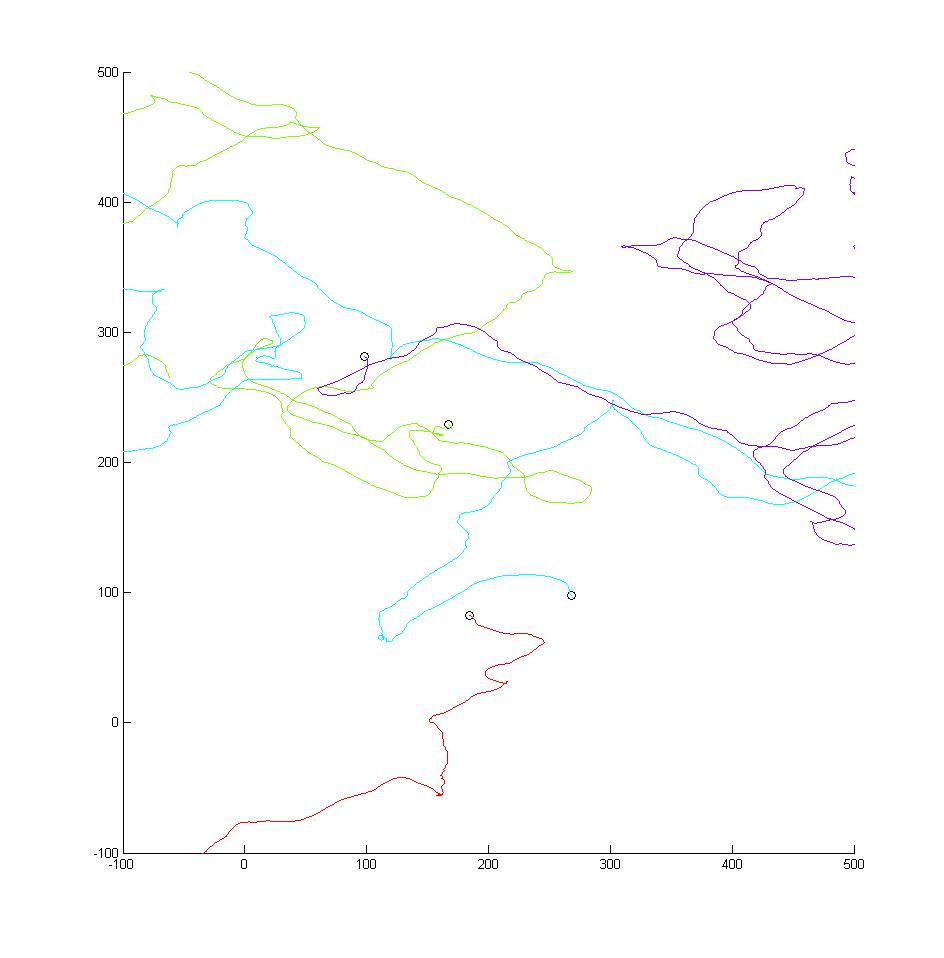I'm trying to write a matlab function that creates random, smooth trajectories in a square of finite side length. Here is my current attempt at such a procedure:
function [] = drawroutes( SideLength, v, t)
%DRAWROUTES Summary of this function goes here
% Detailed explanation goes here
%Some parameters intended to help help keep the particles in the box
RandAccel=.01;
ConservAccel=0;
speedlimit=.1;
G=10^(-8);
%
%Initialize Matrices
Ax=zeros(v,10*t);
Ay=Ax;
vx=Ax;
vy=Ax;
x=Ax;
y=Ax;
sx=zeros(v,1);
sy=zeros(v,1);
%
%Define initial position in square
x(:,1)=SideLength*.15*ones(v,1)+(SideLength*.7)*rand(v,1);
y(:,1)=SideLength*.15*ones(v,1)+(SideLength*.7)*rand(v,1);
%
for i=2:10*t
%Measure minimum particle distance component wise from boundary
%for each vehicle
BorderGravX=[abs(SideLength*ones(v,1)-x(:,i-1)),abs(x(:,i-1))]';
BorderGravY=[abs(SideLength*ones(v,1)-y(:,i-1)),abs(y(:,i-1))]';
rx=min(BorderGravX)';
ry=min(BorderGravY)';
%
%Set the sign of the repulsive force
for k=1:v
if x(k,i)<.5*SideLength
sx(k)=1;
else
sx(k)=-1;
end
if y(k,i)<.5*SideLength
sy(k)=1;
else
sy(k)=-1;
end
end
%
%Calculate Acceleration w/ random "nudge" and repulive force
Ax(:,i)=ConservAccel*Ax(:,i-1)+RandAccel*(rand(v,1)-.5*ones(v,1))+sx*G./rx.^2;
Ay(:,i)=ConservAccel*Ay(:,i-1)+RandAccel*(rand(v,1)-.5*ones(v,1))+sy*G./ry.^2;
%
%Ad hoc method of trying to slow down particles from jumping outside of
%feasible region
for h=1:v
if abs(vx(h,i-1)+Ax(h,i))<speedlimit
vx(h,i)=vx(h,i-1)+Ax(h,i);
elseif (vx(h,i-1)+Ax(h,i))<-speedlimit
vx(h,i)=-speedlimit;
else
vx(h,i)=speedlimit;
end
end
for h=1:v
if abs(vy(h,i-1)+Ay(h,i))<speedlimit
vy(h,i)=vy(h,i-1)+Ay(h,i);
elseif (vy(h,i-1)+Ay(h,i))<-speedlimit
vy(h,i)=-speedlimit;
else
vy(h,i)=speedlimit;
end
end
%
%Update position
x(:,i)=x(:,i-1)+(vx(:,i-1)+vx(:,i))/2;
y(:,i)=y(:,i-1)+(vy(:,i-1)+vy(:,1))/2;
%
end
%Plot position
clf;
hold on;
axis([-100,SideLength+100,-100,SideLength+100]);
cc=hsv(v);
for j=1:v
plot(x(j,1),y(j,1),'ko')
plot(x(j,:),y(j,:),'color',cc(j,:))
end
hold off;
%
end
My original plan was to place particles within a square, and move them around by allowing their acceleration in the x and y direction to be governed by a uniformly distributed random variable. To keep the particles within the square, I tried to create a repulsive force that would push the particles away from the boundaries of the square. In practice, the particles tend to leave the desired "feasible" region after a relatively small number of time steps (say, 1000)."
I'd love to hear your suggestions on either modifying my existing code or considering the problem from another perspective.
When reading the code, please don't feel the need to get hung up on any of the ad hoc parameters at the very beginning of the script. They seem to help, but I don't believe any beside the "G" constant should truly be necessary to make this system work.
Here is an example of the current output:

Many of the vehicles have found their way outside of the desired square region, [0,400] X [0,400].
